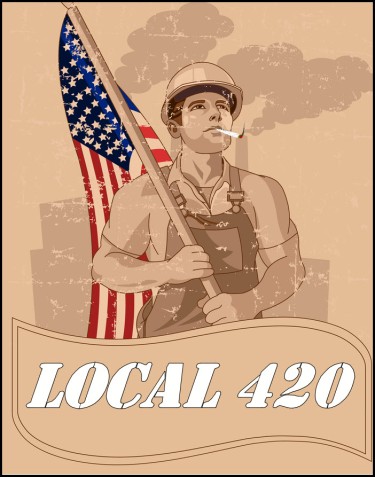
Ultra Cannabis, a recreational dispensary headquartered in Michigan, is demonstrating its solidarity with the committed members and suppliers of the United Auto Workers (UAW) union during the ongoing strike against prominent automakers. In a gesture of support, Ultra Cannabis has unveiled an exclusive 25% discount for all UAW members and supplier associates who provide a valid union ID.
The UAW strike, which commenced on September 15, 2023, has garnered widespread national interest, particularly among Ford Motor Co. employees. General Motors and Stellantis have joined forces to advocate for fair contracts and improved working conditions. As the strike's effects ripple through Michigan, impacting both families and communities, Ultra Cannabis is steadfast in its dedication to providing vital support to UAW members and their suppliers during these challenging times.
Jonathan Yaldo, the owner of Ultra Cannabis, expressed that UAW members and suppliers are more than just customers; they are our neighbors, friends, and extended family. They are committed to alleviating the financial burdens of the strike, and this discount is a small but meaningful gesture to illustrate the strength that comes from unity in assisting one another.
The 18207 West 8 Mile in Detroit dispensary is extending a 25% discount on all recreational cannabis items to UAW members and supplier associates who can present a valid ID. This offer remains accessible for the entire UAW and supplier strike duration.
Strike Expands To 20 States
The United Auto Workers union escalated its strike against major automakers, with workers at all 38 parts-distribution centers operated by General Motors and Stellantis, the parent company of Jeep and Ram, in 20 states walking out. However, Ford was spared from further shutdowns.
Ford managed to avoid additional strikes because the company had addressed some of the union's demands during negotiations over the past week, as UAW President Shawn Fain reported during an online presentation to union members.
Fain noted, "Substantial progress has been achieved at Ford. While significant issues still require resolution, it's important to acknowledge Ford's genuine commitment to reaching a mutually agreeable deal. However, the situation at GM and Stellantis presents a contrasting scenario.
He emphasized that GM and Stellantis, the successor to Fiat Chrysler, have rebuffed the union's propositions concerning cost-of-living adjustments, profit sharing, and job security, stating that they will require significant pressure to agree.
GM stated that it had proposed five "historic" offers encompassing wage and job security considerations. GM characterized the UAW's leadership's decision to escalate the strike as unnecessary, alleging that personal agendas drove it.
Stellantis, on the other hand, asserted that it had presented "a highly competitive proposal." They claim to offer all current full-time hourly employees with earnings between $80,000 and $96,000 within four years and seven months, focusing on "workforce stability" during that period. The company reported that the UAW had yet to respond.
Instead of targeting additional production plants on Friday, the UAW directed its actions toward the distribution centers responsible for supplying parts to car dealer service departments. This strategic move could involve consumers in the dispute if dealers experience shortages of essential elements.
According to the UAW, more walkouts are expected to impact 5,600 more workers and the nearly 13,000 who initiated strikes last week at three Ford, GM, and Stellantis assembly plants. The initial strikes will persist, as confirmed by the union.
It's worth noting that the UAW continues to refrain from targeting plants responsible for producing Detroit's best-selling vehicles, such as the Ford F-150 and Stellantis' Ram pickups. These models account for a significant portion of the companies' revenue and profits. This approach reflects the union's strategy of gradually intensifying the strike's impact on the automakers.
Impact of the Strike
Deutsche Bank analysts have estimated that General Motors (GM), Ford, and Stellantis have collectively lost production of more than 16,000 vehicles since the strike commenced. This strike began at a Ford assembly plant near Detroit, a GM factory in Wentzville, Missouri, and a Stellantis Jeep plant in Toledo, Ohio.
Alongside this, Anderson Economic Group, a consulting firm in Michigan specializing in industry analysis, has calculated that the strike has inflicted approximately $1.6 billion in economic damage. This damage includes over $500 million for the automotive companies and more than $100 million in lost wages for striking workers and those laid off.
So far, the strike has led to the temporary layoff of approximately 6,000 workers by the automakers and some of their suppliers. General Motors even had to close down a factory in Kansas that depended on parts produced at the Wentzville plant.
However, the strike's impact on nationwide car dealerships has not been evident. Analysts suggest it will take a few weeks before a significant shortage of new vehicles becomes apparent, though prices may increase sooner if a prolonged strike prompts panic buying.
Amid negotiations, the union is pushing for wage increases of around 36% over four years, citing the carmakers' substantial recent profits and high CEO compensation as justification.
The companies, in response, have offered a little over half of that amount, citing their need to invest in transitioning from gas-powered vehicles to electric ones. Some of the union's demands, such as 40 hours' pay for a 32-hour work week, have been outright dismissed.
While Ford has made some concessions, including reinstating cost-of-living wage increases and improved profit-sharing and job security, significant gaps still exist in critical economic issues.
The union has been negotiating concurrently with all three Detroit giants instead of focusing on one company and setting a pattern for contracts at the others. By favoring Ford after a week of negotiations, the UAW is following its traditional bargaining pattern of securing the best deal from one company and expecting the others to match it.
The recent escalation of the strike, targeting parts distribution centers, could quickly impact GM and Stellantis. According to analysts, this strategic move is seen as a bold and potentially risky poker move by the UAW. However, some experts believe involving current owners of GM and Stellantis vehicles in the dispute may backfire on the union as those needing car repairs may not be sympathetic to the strike.
Despite the strike expansion, it involves only a fraction of the UAW's total membership, allowing the union's strike fund to last longer as most members continue to work under the expired contract and contribute to the fund. However, an extended strike raises the risk of division among workers receiving entire paychecks and those receiving strike benefits.
Conclusion
The ongoing strike in the automotive industry is causing substantial economic damage, with both carmakers and workers feeling its effects. The negotiations remain contentious, with significant gaps between the union's demands and the companies' offers.
The strike's impact on the availability and prices of new vehicles is expected to become more pronounced in the coming weeks. The dynamic situation will evolve as negotiations progress and the strike's effects ripple through the industry.
CANNABIS INDUSTRY AND UNIONS, READ ON...
CANNABIS INDUSTRY WORKERS JOINS UNION, GETS FIRED, WINS JOB BACK!






